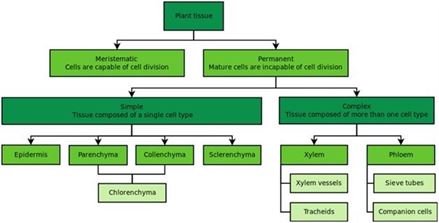
Plants are immobile and hence have been provided with tissues made up of dead cells, which provide structural strength. They have to endure unfavourable environmental situations like strong winds, storms, floods etc.

Plant Tissue System
A tissue is a cluster of cells, that are alike in configuration and work together to attain a specific function. Different types of plant tissues include permanent and meristematic tissues.
Also Read: Tissues
Meristematic tissue:
These tissues have the capability to develop by swift division. They assist in the major growth of the vegetation. Growth in length and growth in diameter of the plant is carried about by these cells. The Meristematic cells are cubical, living cells with a big nucleus. These cells are meticulously crammed with no intercellular spaces. Depending on the section where the meristematic tissues are existing, they are categorized as intercalary, lateral and apical meristems.
- Apical meristem is existent at the growing tips or apical of stems and roots. Apical meristem upsurges the length of the plant.
- Lateral meristem is existent in the radial portion of the stem or root. Lateral meristem upsurges the thickness of the plant.
- Intercalary meristem is found at the internodes or at the base of the leaves. Intercalary meristem upsurges the size of the internode.
Old meristematic cells lose the capability to distribute and convert into permanent tissues. This procedure of capturing up a permanent function, size, and shape is termed as differentiation.
Explore more: Meristematic tissues
Permanent tissues:
These cells have lost their ability to distribute but are specialised to offer elasticity, flexibility and strength to the plant. These tissues can be additionally categorised into:
- Simple Permanent Tissue: They can be classified into sclerenchyma, collenchyma and parenchyma based on their purpose.
- Complex Permanent Tissue: These tissues include phloem and xylem. Xylem is valuable for the transportation of water and solvable constituents. It is made up of xylem parenchyma, fibres, vessels and tracheids. Phloem is valuable in the transportation of food particles. Phloem consists of phloem parenchyma, phloem fibres, companion cells, sieve cells and sieve tubes.
Parenchyma
These are alive, polygonal cells with a big central vacuole, and have intercellular spaces amidst them. Parenchymatous cells create ground tissue and pith.
- Parenchyma consisting of chloroplasts are termed as chlorenchyma. The chlorenchyma helps in photosynthesis.
- Parenchyma which consists of big air voids is called aerenchyma. Buoyancy is the main purpose the aerenchyma.
- Some parenchymatous cells perform as storage chambers for starch in vegetable and fruits.
Collenchyma
These are stretched out, living cells with minute intercellular gaps. Their cell walls are made up of pectin and cellulose. Collenchyma is found in the marginal regions of leaves and stems and offers flexibility with the structural framework and mechanical support to plants.
Sclerenchyma
These are elongated, dead cells with lignin deposits in their cell wall. They have no intercellular gaps. Sclerenchyma is found in the covering of seeds and nuts, around the vascular tissues in stems and the veins of leaves. Sclerenchyma provides strength to the plant.
Xylem
It helps in the transport of dissolved substances and water all through the plant. The diverse components of the xylem include vessels, tracheids, xylem fibres and xylem parenchyma. Xylem fibres and Tracheids are made up of lignin, which provides structural support to the plant.
Phloem
This tissue helps in the transportation of food all through the plant. The diverse elements of phloem include phloem fibres, sieve tubes, phloem parenchyma and companion cells.
Also Read: Difference Between Xylem And Phloem
Protective tissues
These provide fortification to the plant. They include the cork and epidermis.
- Epidermis – It is a layer of cell that makes up an outer casing of all the structures in the plant. The stomata perforates the epidermis at certain places. The stomata help in loss of water and gaseous exchange.
- Cork – This is the external protective tissue, which substitutes the epidermal cells in mature stems and roots. Cork cells are lifeless and lack intercellular gaps. Their cell walls are coagulated by suberin, which makes them impervious to gas and Water Molecules.
Also Read: Difference between Tracheids and Vessels
Learn more in detail about plant tissue system, its types, functions and other related topics @ BYJU’S Biology

Thanks for the information.
This information is very useful.
Thank you so much for the information which is very useful to us
Thanks a lot for your information it’s very useful to me and my doubt was cleared
An extremely useful guide and perfect information provided in this sample. Highly efficient. I used it to study for my Biology examination. Thank you.
Really it helped me a lot in my exams and thank you soo much for making my exams easier
Good. I always prefer Bjyus whenever I have doubts…..???♥️♥️♥️
Thank you very much ??